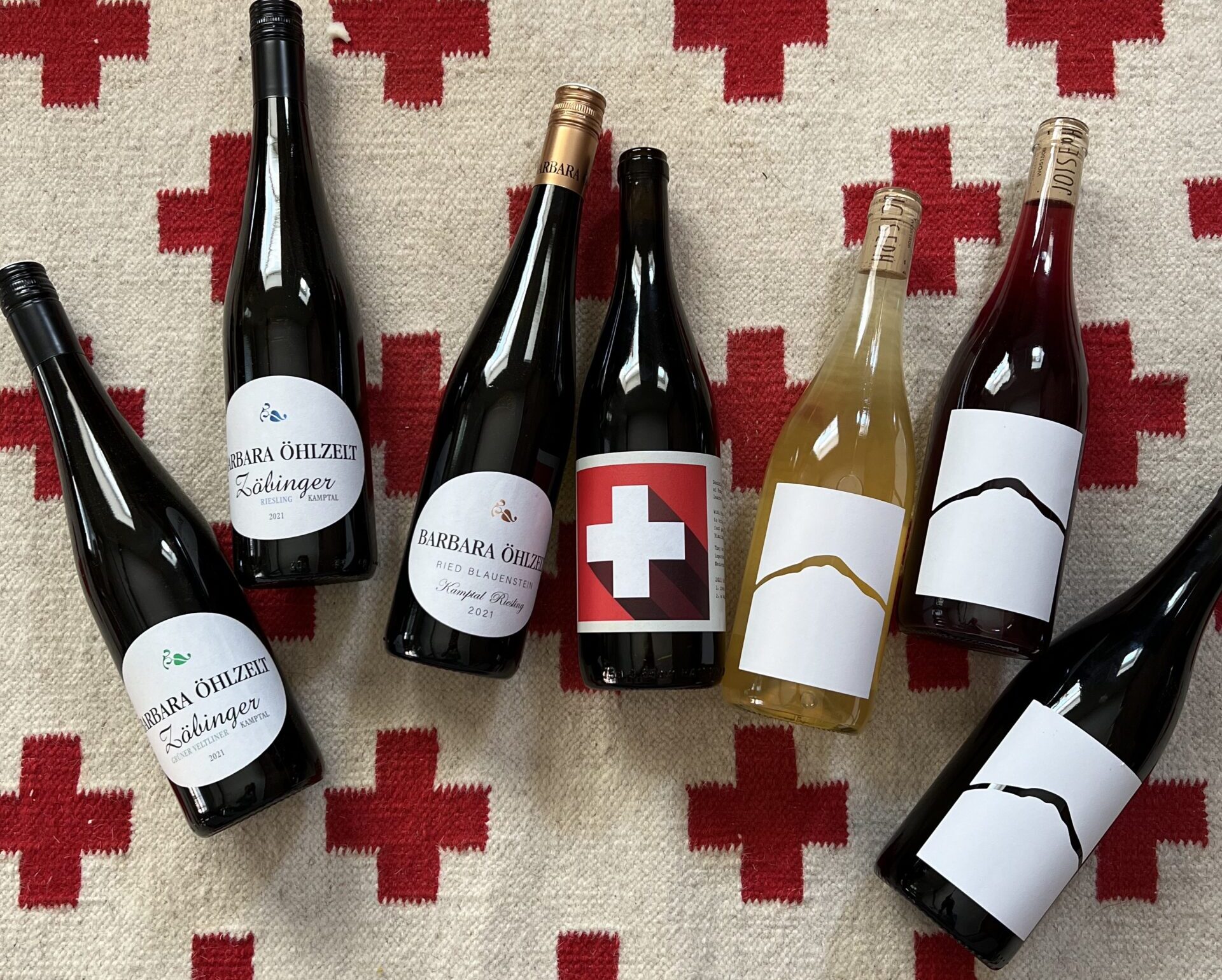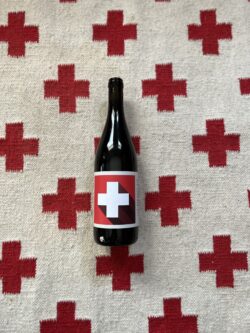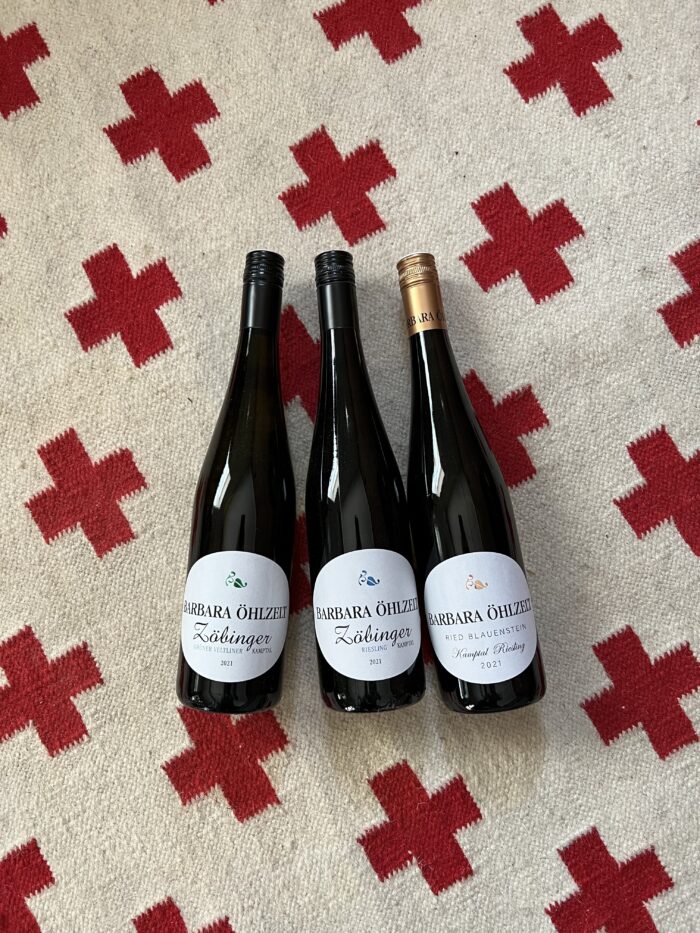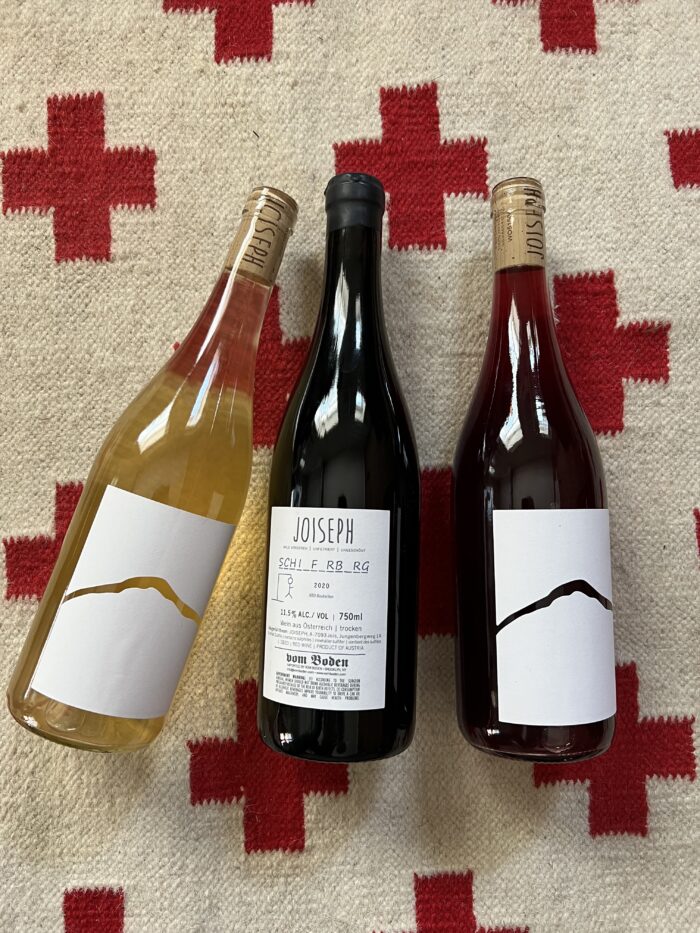We have, perhaps never(?), had this much Austrian wine in stock at one time; it is a veritable smorgasbord. It also only consists of eight unique bottlings from three growers.
If you are in the business, please ask us for an Austrian portfolio tasting!
Hell, we’ll bring it to you. It’ll take you twenty minutes to taste through everything and we’ll still have enough time to talk about the best Würstelstand in Wien (Würstelstand am Hohen Markt, duh).
Yes, this is a small portfolio, but I could honestly not be more proud, more connected with these growers or more certain that what they are doing is relevant, unique, soulful and (a critical point to be made regarding Austrian wine) very fairly priced. It would be very easy to make this portfolio bigger – it’d certainly be more profitable. But we are nothing if not harsh editors, for good and for bad, I’ll admit that.
Maybe what I’m most proud of about our humble micro-book, is that all these growers, in their own ways, have a Clos Roche Blanche vibe – honest, clear, fresh, products of a farm, of agriculture, humble. A grocery you can drink, with friends, on a Tuesday and feel no need to Instagram the experience.
That’s a nice feeling.
If you’ve read any of my nonsense writing on wine, I use the Clos Roche Blanche example a lot – maybe too much. But I do this because for me those wines are both canonical and something of a lesson. How do we love something, honestly, for the very reason that we sense in it something honest… yet also keep it from being fetishized, from becoming a collected commodity?
The answer of course, I guess, is we can’t? But it’s nice when this happens. And so far, this has (or has not?) happened with these growers. We sell them easily, they seem to be bought and drunk up. I do as much of the drinking up as I can. I think they are loved, with not that much of a show. This is awesome.
I’m content to keep it this way, but I did also want to write a little bit about both of them, simply because I really care about these people and I care about these wines. Also the 2021 vintage is superb, superb, superb (so I’m told) and I want to give praise and recognition where praise and recognition is due. Simple as that.
Please read, please buy and drink and enjoy these wines. If you have any questions, a real human – either myself or Collin or the other Collin – will respond to you at orders@vomboden.com.
Here’s the skinny on the eight bottlings that have just arrived; then there’s a collection of a bunch of meandering thoughts on these estates that we also hope you’ll read?

2021 Barbara Öhlzelt Grüner “Leader” ~$20
This is a liter bottle of Grüner Veltliner: liter, “Leader,” get it? If the packaging is clever (and it is, thank you), the wine is actually important. Here we have a liter of honest Grüner Veltliner that isn’t trying to approximate Pinot Grigio. You may not like the style, that’s fair enough – but this is the most linear and crisp Grüner in the category, bar none. This is Barbara’s style, her aesthetic, and I value the fact it is reflected in even her most basic wine.
2021 Barbara Öhlzelt Grüner “Zöbing” (village level) ~$27
2021 Barbara Öhlzelt Riesling “Zöbing” (village level) ~$28
These are Barbara’s village-level wines, sourced from younger vines in vineyards scattered around her hometown of Zöbing. Both wines have more texture and density than the liter, as you’d expect. Both, however, have an elegance, a seamlessness and energetic mineral core to them. They have lift; they are salty and refreshing and you will want to drink a lot. This push-pull of depth and levity, this you would not expect.
2021 Barbara Öhlzelt Riesling “Blauenstein” (single vineyard) ~$32
This is a single-vineyard wine; it’s bonkers good – prominently, like jaw-droppingly, mineral – a sorta Steinertal of the Kamptal, with Barbara’s touch. It does taste like Riesling from slate and if the name, “Blauenstein,” or “blue stones” suggests as much, this is only partly true. Yes, there is some slate in this terraced vineyard at about 300 meters (1,200 feet) elevation, there is also gneiss and amphibolite. In fact it is the amphibolite, says Barbara, that gives the stones in the vineyard their blue color. So there.
2021 Joiseph “Mischkultur” ~$30
This is a semi-mindblowing wine; I mean, deceptively simple, yet when you dig a bit deeper… for example, it’s a richer wine, with broad shoulders and some power and momentum. Yet, the minerality and lift is potent, with a brisk acidity that balances and integrates the herbal freshness. It’s citric, with delicate peach and even some ripe tropical undertones… I guess you call this complex? But it’s also energetic and deeeeeeeelicious. Only about 1,500 liters made.
2021 Joiseph “Piroska” ~$30
Harvested normally a bit early, this joyous, delicate red flaunts a finely wound structure, herbal with a bright strawberry treble and deep cassis bass note, all supported by a rocky minerality. It’s a blend: normally Zweigelt and Pinot Noir with the remainder being just a “gemistcher satz” that is mostly Blaufränkisch. This is “chilled red” perfection.
2020 Joiseph “Schieferberg” ~$50
The Schieferberg is one of Joiseph’s coolest and steepest vineyards (steep for Burgenland let’s say). It’s nearly solid schist and the vines here are 40 plus years old; this is a Blaufränkisch. In any given year they only make about 600 liters or so – that’s less than 70 cases, total. They also tend to release it a bit later, as the wine can be a bit ornery. Thus we have the 2020. The Schieferberg tends to be both bright and dark; it has a red-fruited energy, yet it is brooding and darker (cacao, dark anise, dried spice). It is certainly more structured, with angular acids and fine-grained but rustic tannins providing a flash of grip and bone. Honestly, for those of you that know Joiseph’s “basic” Blaufränkisch, the “BFF,” this is for me at least one of the most perfect Austrian Blaufränkisches from Burgenland: generous and plump, saturating, yet light. The Schieferberg has less to do with Blaufränkisch and more to do with the site; it is a bit more raw and animal, deeper, more complex and sinewy. Pair with the Northern Rhone.

2021 Vineyard Project 004 Blaufränkisch ~$22
We were turned on to these two growers – Dominik and Gerald – by our friend Franz Weninger, whose wines we’ve always appreciated. We were in fact looking to do a “Vineyard Project” wine with Franz; he had a friend with good vineyards that he thought might need help and be open to more organic viticulture. In the end, it didn’t work; most often in life it doesn’t work, remember that. It’s ok.
Then, maybe a year later, Franz wrote to us about these two growers – maybe you remember Dominik and Gerald from the last paragraph? – and said they were thinking of working a few really good vineyards and that they had a great sensibility and that they could probably use a partner to help them get the winery started?
If you want to know the real truth, then COVID hit. And so there we were, all of us quarantined at home and all international travel, difficult and dangerous. Franz said, basically, “The wine is fucking very good just buy it.” And John and I, honestly just not knowing what to do, said “uh…ok.” And so we committed to tens of thousands of dollars of wine, without ever tasting it or meeting the people. (Honestly this is the first and last time that will ever happen.)
In a way, I’m probably telling this story because I’m proud of it. John constantly ribs me about my worrying, about my slightly neurotic tendency to overthink everything, always. I guess I’m proud that I made the jump, that we made this jump, for all the right reasons. I’m also probably telling this story because it has a very happy ending. The wine was awesome, like Franz said. It was juicy and satisfying, yet compact and not heavy, not cumbersome and gooey. It felt fresh. We loved it; judging by the sales you loved it too.
The spectacular 2021 vintage has just arrived; it is spectacular. At around $20 retail, it is also absurdly well priced.
When I finally met Dominik and Gerald, we had a great tasting and at the end, buzzing a little bit maybe, they admitted to being anxious to meet me. They said something like: “I mean, who buys that much wine without ever having tasted it? That was crazy.”
I told them casually I do this stuff all the time, no big deal.
Part of me wants to go to every street corner and yell: “BARBARA MOTHER****ING ÖHLZELT! What are you people doing?”

The result of screaming these profanities – after being released on bail – would amount to nothing, of course. But there is such a jarring divide between what these wines are to me personally, and how they are, I think, perceived in the general market, which makes me feel a bit insane.
To me Barbara has among the most delicate touch of any vintner in Austria, full stop.
I think the market perceives the wines as very good Austrian wines. Grüners and Rieslings at appropriate prices.
With all due respect, please taste these wines again.
Think not of the Kamptal, with its often gushing, creamy, weighty thoroughbreds, but of the Wachau wines more concerned with delicacy. I love the focused wines of Alzinger, of Knoll – to me Barbara’s wines are different but also the same.
Is it crazy to compare Barbara’s wines (the Rieslings at least) to the more linear Rieslings of Germany’s Pfalz – Rebholz and Hammelmann? To the Rheinhessen? Even the Nahe?
At the most obvious level, yes this is all insane, though at the same time there is something about the phenolic grip of Barbara’s wines, the tactile, herbal, quinine-like structure of her top single-vineyard wines that remind me very much of Emrich-Schönleber.
I have had this very specific reaction on more than one occasion. In fact I had this feeling so strongly that I had to open an Emrich-Schönleber alongside an Öhlzelt to see if I was literally just going insane.
For the record, it turned out I was not in fact going insane, at least not yet. There is much to discuss here.
I do think much of the lag time between my perception and the market could just be timing. I think when I first started tasting with Barbara her basic wines were very, very good… and maybe the upper-echelon wines were perhaps not quite as shimmering as they could be.
In the last five years, she has just gotten much, much better. The basic and village-level wines have their bounce and refreshing vibrancy; the single-vineyards now somehow keep this energy, yet it is more elegant and structured and… well more formal – more specifically of a place.
The three “Grand Cru” single-vineyard wines will arrive later this year: a Grüner from Lamm and two Rieslings, one from the Heiligenstein and one from the Kogelberg. Pair with Emrich-Schönleber?
Burgenland has become the thing.
Or maybe it was “the thing” and now the focus has moved on? I have the vague sense that PIWI’s from Steiermark are now “the thing”? Is this true? Can anyone confirm?
Austria has a way of doing this, of rapidly sensing, digesting and seamlessly incorporating new trends into its winemaking culture, almost before any of us are conscious of the trend or the assimilation. It quickly becomes such a part of the landscape that you forget that a minute ago, this thing was not there. I write this with some affection and respect. It is an aspect of intuition that I admire, even if I have none of it personally.
In the twenty years I’ve been following Burgenland and its wines, the region showcased “Ausbruch” — exemplary, we were told, because of the shallow lake, the fog, the botrytis, etc. Lots of 100-point sweet wines came from here, unctuous, deeply golden 375ml bottles of luxury. Then came Heidi Schröck, showing the world you could make dry aromatic wines of clarity and balance in this place. There were the Velich brothers showing you could make dry, rich wines; then Roland went out on his own and dropped the mic with Blaufränkisch of unparalleled classicism and depth. Then, as the wine world went natty, Austria became almost overnight the eastern front for the movement; the Loire of the Austro-Hungarian empire, albeit with a little more sophisticated label design and the price tags to boot.
I’m not 100% sure how Joiseph fits into this narrative. Which is, of course, a huge part of the resonance, at least for me.
Yes, the more obvious aesthetic is perhaps a bit “natural,” though this feels to me very surface. Sure, they make a delicate red and it can be subtly cloudy; this, however, does not a natty wine make. To me, the deeper sensibility at Joiseph is one of elegance, a concern for clarity and harmony and balance. Not that natty wine can’t be clear or harmonious or balanced – far from it, obviously. But more that I think the core of natural wine is a certain minimalism in process and a belief that an authentic truth (however that is defined by the winemaker) is more important than elegance or clarity or balance.
I realize I’m treading on thin ice, on very intricate ideas that I’m not completely articulating.
So let’s come at this from a completely different angle, a totally different insight into Joiseph. I think this anecdote speaks volumes about Joiseph even though I’m not exactly sure how or why.

One time when John and I were in Austria – I believe it was in December of 2019, for Karakterre – we went to taste with Luka, the winemaker at Joiseph. We went to his home, in the south of Burgenland near the Hungarian border. It was a cold, dark winter and dusk came early, as it does. He was living at the time at the old home of his grandparents. Very simple quarters; a kitchen with a wood burning stove. To one side was a pantry, to the other side was the main room of the home, serving both as bedroom and living room. In this room too a wood-burning stove crackled; we sat down for a hearty late lunch / early dinner. Luka quietly poured us some wines and sat down at the tiny table. We ate and began tasting through the wines and at one point, Luka got up and put on a record. He neither asked us if we wanted to listen to anything, nor what we liked or might want to hear. I really like classical music; John studied music, but I don’t think we had ever really talked music. Anyway, Luka just got up, quietly put on a record and sat down. Beethoven’s late string quartets began to play – John believes it was a record of the Budapest String Quartet on Deutsche Grammophon.
And we just sat there, bringing these honest wines to our noses and lips and talking and laughing and listening to the snow begin to fall outside. There was something about this moment that was so magical, transportative. It all felt timeless, the moment, the food, the wines. This could have been Austria in 2019 or 1810, with Beethoven at the height of his prowess. The moment felt, well, classic.. classical?
Curiously, John and I have spoken about this tasting many times since, though never in great detail – because there isn’t any great detail, no one grand thing to discuss. It was just simple and honest and perfect and when you have a moment like that, you feel it and that’s it. You can acknowledge this moment and savor it, that’s all.
We had never spoken about it with Luka. What the hell do we know? They don’t make that much wine but he probably has a lot of tastings and maybe this wasn’t quite the same moment for him?
Then, as we were writing to him this month (August, 2022) about the specifics of one order or another, just random administrative details one has to have right, he finished an email with this line, verbatim: “And I also often think back to our nice tasting in our old house with Ludwig Van in the background. Such nice moments.”
So what the hell are you saying Bitterolf? Because the dude put on some Beethoven and you all listened quietly the wines are more classical and less natural? No! But yes, maybe? I don’t totally know if any of this resonates or makes sense in trying to give one a sense of Luka, of Joiseph and this very curious, very beautiful and subtle space in which they work, but do try and taste the wines. Put on some Beethoven; the later, quieter works.
And then just listen and taste.